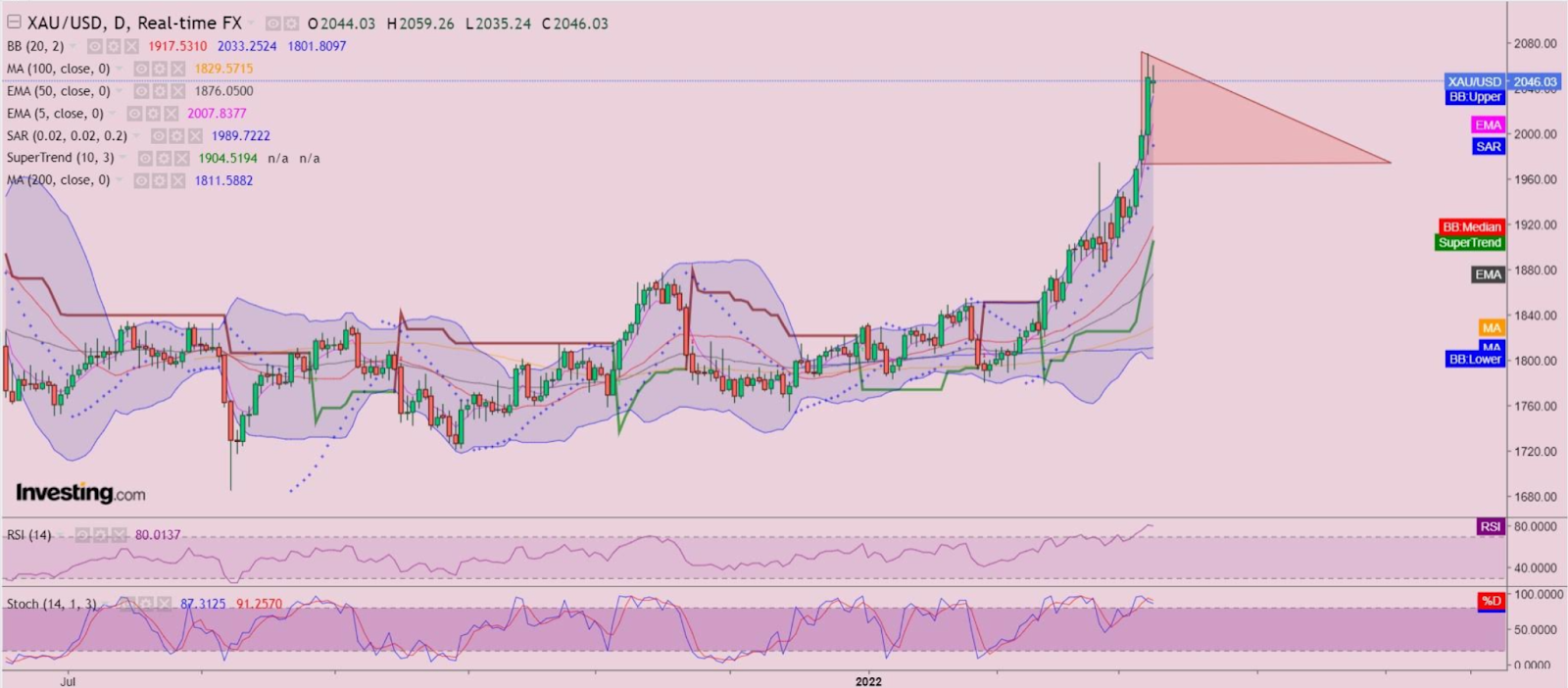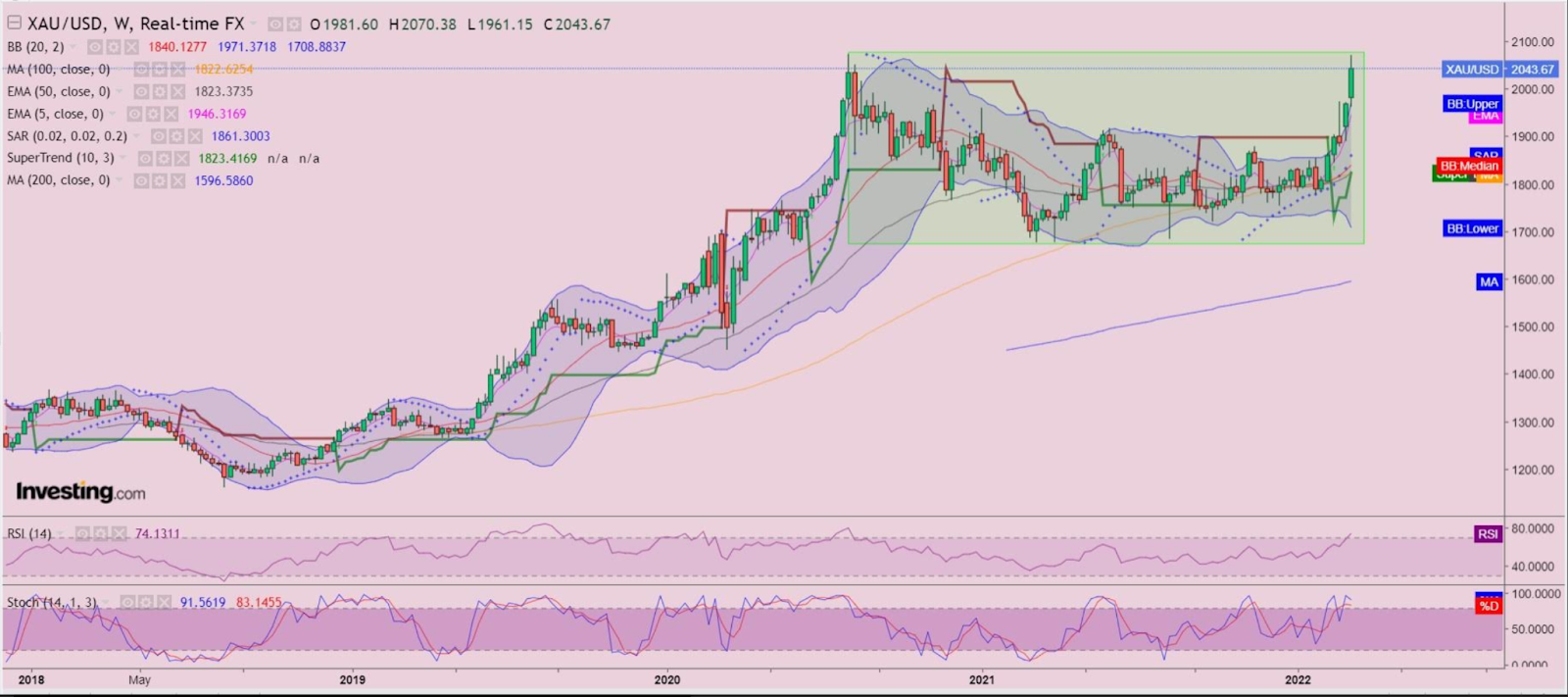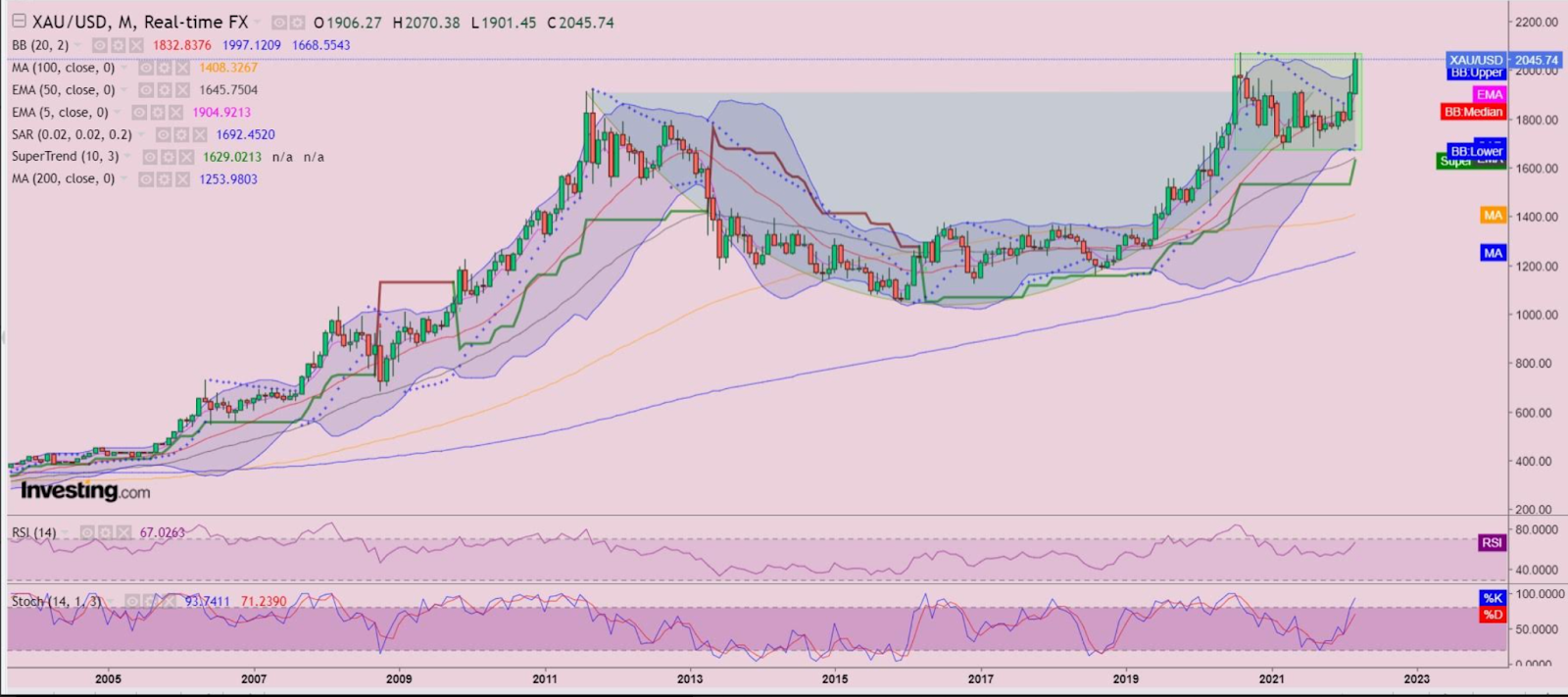From the virtual circus in nickel trading, where there seem to be only buyers at the top, to the measured highs in copper, commodities appear to be in a hard-to-fail place now.
Ensconced within this is gold and its imminent strike at record highs, above levels last seen in August 2020.
A solid favorite of safety-minded investors during the early days of the pandemic, gold fell out of favor in early 2021 as stocks, Treasury yields and the dollar took off instead as COVID vaccine drives revived risk appetites.
From there, it witnessed multiple failed starts and a drop to below $1,700 an ounce at one point, as doubts grew about its long-standing hedge against economic and political troubles. But now, gold’s back where it was 19 months ago—the $2,000 berth.

With US inflation at four-decade highs and the festering Russia-Ukraine war fanning gold’s wings like they never have over the past year-and-half, all sorts of price projections are being made for the yellow metal—from a modest $2,200 that would just rewrite its previous peak to lofty highs of above $3,000.
We are in frightening times as unrestrained energy prices threaten to gobble up more of our income by the day, while the escalating confrontation between Russia and Ukraine puts the world at risk. All these suggest that investors need a store of value that’s beyond any security that even the safest fiat currency—the dollar—can offer.
That store of value would most likely be gold, which has been making higher highs and higher lower over the past two weeks—a perfect proposition for a bull market
But gold’s history also shows a commodity that’s never been wildly out of control, with the typical zaniest daily move under 5%. Thus, you won’t get a nickel-like situation where the price of the Russia-dominated battery-making material went up fourfold in just four days.
You could, however, get a $400 premium over gold’s August 2020 top that will likely build over the next few months. That’s the premise that I and my long-time collaborator on commodity charts, Sunil Kumar Dixit of skcharting.com, have after poring over near- and medium-term technicals of gold.
But getting to the technical analysis, below, some fundamental views from analysts.
“Now that real yields are dropping in the context of a risk-off environment in financial markets, gold prices have renewed appeal,” Christopher Vecchio, senior strategist for precious metal, said in a blog that appeared on DailyFX.
Added Vecchio:
“It’s not just gold prices finding a bid in as a safe haven—though that’s a big contributor. Last week it was noted that ‘it’s World War 3 or bust, if gold prices are going to have any chance at a return to their highs,’ … and for all intents and purposes, we seem to have embarked down that path.”
Vecchio also noted that historically, gold prices have a relationship with volatility, unlike other asset classes. He explained:
“While other asset classes like bonds and stocks don’t like increased volatility—signaling greater uncertainty around cash flows, dividends, coupon payments, etc.—gold tends to benefit during periods of higher volatility.”
“As war continues to rage in Eastern Europe, gold volatility has remained elevated, supporting the surge in gold prices.”
So, there you go: Gold’s proven tendency to swing beyond certain high or low ensures that you’ll never get a parabolic move like that in nickel—or for that matter palladium, which jumped $1,000 an ounce, or 42%, in less than 10 days to reach a record high above $3,417.
Goldman Sachs, meanwhile, has changed its 3-month forecast on gold to $2,300 ounce from a previous $1,950—putting on a $350 hike that somewhat matches the $400 premium that I and Dixit have laid out.
Goldman also moved its 6-month outlook for gold to $2,500/oz, from a previous $2,050 and the 12-month horizon to $2,500 from $2,150.
It attributed the hikes to an increase in demand from consumers, investors, central banks, and to “rising geopolitical uncertainty.”

Gold futures on New York’s COMEX reached a record high of $2,221.70 on Aug. 7, 2020. In Tuesday’s trade, COMEX gold hit $2,078.80. At the time of writing, it hovered at $2,050.
The spot price of bullion reached an all-time high of $2,073.41 on Aug. 7, 2020. On Tuesday, bullion got to a session high of $2,070.29—just $3.12 short of the previous apex. At the time of writing, spot gold was at around $2,042.
Dixit, basing his read on the spot price, said with gold virtually challenging its $2,073 peak, the next breakout had a $400 upside potential forming a classic rectangle formation on the weekly bullion chart.
“But gold also needs to consolidate below the $2,073 resistance and the $2040-$2020 support before clearing through the $2073 for the next immediate targets of $2100-$2120-$2150,” he added.

He said a decisive weekly and monthly closing above $2,100-$2,150 would be a reliable affirmation for the $2,470-$2,500 move, probably sometime in the second quarter.
“On the side of caution, the point to watch would be reaction to dips, when the price reaches $1,980-$1,970, as this area would be the make-or-break zone on correction.”
Disclaimer: Barani Krishnan uses a range of views outside his own to bring diversity to his analysis of any market. For neutrality, he sometimes presents contrarian views and market variables. He does not hold a position in the commodities and securities he writes about.
